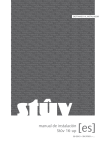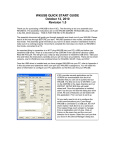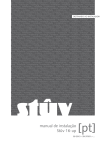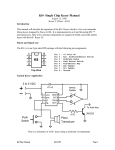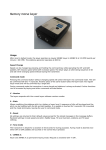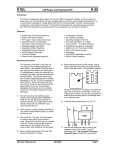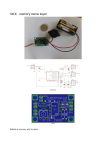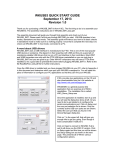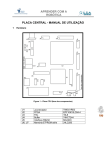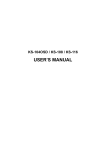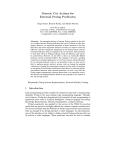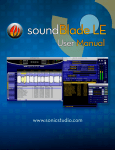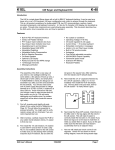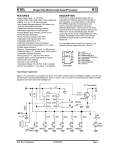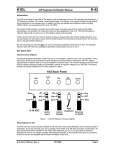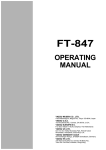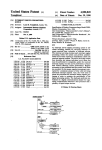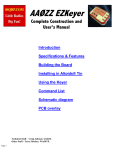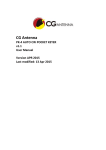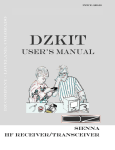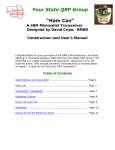Download K20 Serial Interface Guide
Transcript
K1EL CW Keyer and Keyboard Serial Interface Guide K-20 Introduction The K20 is a single board Morse keyer with a built in IBM AT keyboard interface. It can be used as a keyer only or as a CW keyboard. This document will describe how to interface to the asynchronous serial port of the keyer and drive it from a personal computer or other host. The interface is based on a simple set of ASCII commands. The K20 provides a single handshake line that tells when it is ready to accept data. Command Set The K20 only accepts asynchronous serial data at 1200 baud. The format must be 8 data bits, 1 stop bit, with no parity. Note that the K20 must be modified to accept RS232 data, see the K20 hardware modification section for details. Normal alphanumeric characters will be sent as Morse letters, commands are control characters, which are listed below. Special characters such as prosigns are listed in a separate table. When formatting a command no spaces should be added between commands and/or arguments, also numeric values must always be sent as two decimal digits with a leading zero if the value is less than 10. The only exceptions to this are the MODE register command in which the value is sent as a two digit hexadecimal value. Immediate Commands ^A ^B ^C ^D ^E ^F ^G ^H ^I ^J ^K ^L ^M ^N ^O ^P ^Q ^R ^S 01h 02h 03h 04h 05h 06h <nn> 07h 08h 09h 0Ah 0Bh <nn> 0Ch <nn> 0Dh <hh> 0Eh <list> 0Fh <nn> 10h <nn> 11h <nn> 12h <tl> 13h <nn> <nn> <nn> <nn> <nn> nn nn nn nn nn Set sidetone frequency to nn where nn = 4 – 0AH (see table below) Set keying speed to nn WPM where nn = 05 - 99 Set Dit/Dah Ratio to nn/10 nn = 05 - 32 Set PTT Lead-In delay to nn*10 milliseconds nn = 00 - 99 Set PTT Tail delay to nn*10 milliseconds nn = 00 - 99 Pause transmit On/Off nn Flow Control Count 01 – 30 (change not recommended) Backspace buffer input pointer Say Status Clear circular buffer and abort current process Key Down on/off nn Set HSCW speed to nn*100 LPM nn Set Extraspace to nn/10 nn = 05 - 32 h Set Mode Register to hex value hh (see Mode Reg. Description) <….> Load Keyer Default List (see Defaults Description) nn First bit extension to nn milliseconds nn = 0-99 nn Set Weighting Adjustment in milliseconds nn = 0 – 99, 50 = 00 nn Adjust swing sensitivity nn = 0 - 99 tl Start Practice t=e/r l=1,2,3,4 (see K20 User Guide) Buffered Message Commands ^V ^W ^X ^Y ^Z ^\ ^] ^^ <xy> <nn> <nn> <nn> 16h 17h 18h 19h 1Ah 1Ch 1Dh 1Eh nn xy nn nn nn PTT on/off Key on/off Wait for nn seconds nn=0-99 Merge letters x,y Change WPM speed to nn WPM nn=5-99 Analog diagnostic Set HSCW speed to nn Set loop timer to nn nn=0-99 Special Characters / : < BT DN KN AR K20 Serial Interface Guide = > @ [ BT SK AS QRZ ] QSL DEL 8 dits 10/10/00 Page 1 K1EL K20 CW Keyer and Keyboard Sidetone Values Value 01h 02h 03h 04h 05h 06h 07h 08h 09h 0Ah Frequency 4000 hz 2000 hz 1333 hz 1000 hz 800 hz 666 hz 571 hz 500 444 hz 400 hz Mode Register Description There is an eight-bit byte in the Keyer PIC that contains bit flags that control the operation modes of the keyer. Each bit’s state controls a particular mode, following is a table showing the bit functions: Bit 7 (MSB) 6 5 4 3 2 1 0 (LSB) Function Iambic A when = 1 Iambic B = 0 Farnsworth on when = 1 Bug Mode on when = 1 Softsidetone on when = 1 Swap paddles when = 1 Disable sidetone when = 1 Autospace On when = 1 Mute Transmit when = 1 Power Up State 0 0 0 0 0 0 0 0 Defaults Description All of the Keyers internal state registers can be initialized in one block transfer. This feature is useful for fast initialization or for changing the whole configuration of the keyer quickly. The following illustrates how the command is issued and the order of control words loaded. Byte # 0 1 2 3 4 5 6 7 8 9 10 Value 0Fh (command) Mode Register Value WPM Speed Sidetone Value Dit/Dah Ratio Lead In time Tail Time st 1 Bit Extension Weighting Extra Space Sample Adjust Power On Default N/A 00 15 05 10 00 00 00 50 10 10 Hardware Modification The K20 was originally designed to have the Console PIC provide the serial input to the Keyer PIC. To operate the K20 with an external serial data source the Console PIC must be removed from its socket and wires are soldered to two unused hole positions on the K20 PCB. One wire is for serial data to the K20 the other is a flow control (ready) output. These signals are connected to a host which provides all control to the K20. The paddle inputs to the Keyer PIC are unaffected and work normally. The host must monitor the flow control line, if it is high the host must wait till the K20 drops it before sending any additional bytes. K-20 User’s Manual 10/10/00 Page 2 K1EL K20 CW Keyer and Keyboard Keyer U1 R6 C8 C9 C onsole (remove) U2 U3 T ransmit Serial D ata Input to K20 F low C ontrol Output to H ost Connections to K20 For External Serial Data Control If the host provides true RS232 formatted signals, a level converter MUST be installed between the host and the K20 or damage will result. Standard RS232 levels transit between –12 and +12 volts DC while the K20 expects 0 to 5 volts. There are several RS232 level converters available from Maxim that supply all the interface details in one package. Typical ones to look at are the MAX232 and the MAX203. Following is a diagram of a typical application using the MAX 232 1 uF +5 V o lts 16 1 2 1 uF 1 uF 3 4 6 1 uF 1 uF 5 MAX 232 F ro m K 2 0 F lo w C o n tro l O u tp u t T o K 2 0 R e c e ive In p u t 11 14 T o R S 2 3 2 C T S In p u t 12 13 10 8 F ro m R S 2 3 2 T ra n s m it O u tp u t 15 RS232 Level Translator K-20 User’s Manual 10/10/00 Page 3



